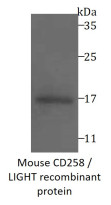ARG70404
Mouse CD258 / LIGHT recombinant protein (Active) (His-tagged, C-ter)
Mouse CD258 / LIGHT recombinant protein (Active) (His-tagged, C-ter) for SDS-PAGE
Overview
| Product Description | E. coli expressed, His-tagged (C-ter) Active Mouse CD258 / LIGHT recombinant protein |
|---|---|
| Tested Application | SDS-PAGE |
| Target Name | CD258 / LIGHT |
| Species | Mouse |
| A.A. Sequence | Arg58 - Val239 |
| Expression System | E. coli |
| Protein Full Name | Tumor necrosis factor ligand superfamily member 14 |
| Activity | Active |
| Activity Note | Determined by its ability to induce cytotoxicity in HT-29 cells. The ED50 for this effect is < 2 μg/mL. |
| Alternate Names | TNFSF14; TNF Superfamily Member 14; LIGHT; HVEM-L; CD258; LTg; Tumor Necrosis Factor (Ligand) Superfamily, Member 14; Tumor Necrosis Factor Ligand Superfamily Member 14; Herpesvirus Entry Mediator Ligand; HVEML; Tumor Necrosis Factor Superfamily Member 14; Herpes Virus Entry Mediator Ligand; Tumor Necrosis Factor Ligand 1D; CD258 Antigen |
Properties
| Form | Powder |
|---|---|
| Purification Note | Endotoxin level is less than 0.1 EU/µg of the protein, as determined by the LAL test. |
| Purity | > 98% (by SDS-PAGE) |
| Buffer | PBS (pH 7.4) |
| Reconstitution | It is recommended to reconstitute the lyophilized protein in sterile water to a concentration not less than 200 μg/mL and incubate the stock solution for at least 20 min at room temperature to make sure the protein is dissolved completely. |
| Storage Instruction | For long term, lyophilized protein should be stored at -20°C or -80°C. After reconstitution, aliquot and store at -20°C or -80°C for up to one month. Storage in frost free freezers is not recommended. Avoid repeated freeze/thaw cycles. Suggest spin the vial prior to opening. |
| Note | For laboratory research only, not for drug, diagnostic or other use. |
Bioinformation
| Gene Symbol | TNFSF14 |
|---|---|
| Gene Full Name | TNF Superfamily Member 14 |
| Background | The protein encoded by this gene is a member of the tumor necrosis factor (TNF) ligand family. This protein is a ligand for TNFRSF14, which is a member of the tumor necrosis factor receptor superfamily, and which is also known as a herpesvirus entry mediator (HVEM). This protein may function as a costimulatory factor for the activation of lymphoid cells and as a deterrent to infection by herpesvirus. This protein has been shown to stimulate the proliferation of T cells, and trigger apoptosis of various tumor cells. This protein is also reported to prevent tumor necrosis factor alpha mediated apoptosis in primary hepatocyte. Two alternatively spliced transcript variant encoding distinct isoforms have been reported. |
| Function | Cytokine that binds to TNFRSF3/LTBR. Binding to the decoy receptor TNFRSF6B modulates its effects. Acts as a ligand for TNFRSF14/HVEM. |
| Cellular Localization | Cell membrane, Cytoplasm, Membrane, Secreted |
| PTM | N-glycosylated. |
Images (1) Click the Picture to Zoom In






